Tennis Magazine's 101 tips: Serve
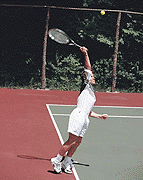 #1 Eyes wide shut #1 Eyes wide shut Once you've developed a sound service motion, it's important that you toss the ball into the same spot each and every time. When I was first learning to serve, I was told: "You should be able to serve with your eyes closed, because the ball should be in the same spot every time." So when I was a kid, I used to practice hitting serves with my eyes closed. I really didn't care where it went, but if the ball made contact with the racquet strings, that meant the toss was in the right spot. --Paul Annacone |
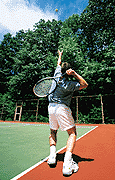 #2 Knock Knock #2 Knock Knock The key to having a powerful serve is in creating a loop in your backswing and letting your racquet head drop behind you as you toss the ball. This lengthens the swing, and more length means increased power. If you're a beginner and don't feel comfortable with the loop concept, try tapping your back twice during your service motion. It may feel awkward at first, but by practicing your serve and tapping your back twice, you'll see just how much time you have to make that loop. Then, once you begin to serve without tapping your back, adding the loop to your backswing and dropping your racquet into the back-scratch position will be a breeze. --Dennis Van der Meer |
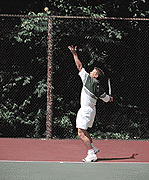 #3 Who's sorry now? #3 Who's sorry now? I know a lot of people are too embarrassed to catch a bad toss and then say "sorry" to their opponent. But by hitting errant tosses, you'll change the way you swing and lose consistency -- and probably lose your balance as well. If you're a right-hander, toss the ball to one o'clock (slightly to your right). Lefties should toss the ball to the 11 o'clock position (slightly to your left). --Tracy Austin |
| #4
Make mine a double The only way you'll ever improve your second serve is to double-fault at critical times in a match. Yes, that's right -- double fault. Over time, hitting out and going for your second serve will build up your confidence in the shot. --Nick Bollettieri |
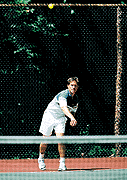 #5 Swing, batter! #5 Swing, batter! Serving requires using the big muscles of the body. Ask Pete Sampras, Boris Becker, or Goran Ivanisevic where their power comes from and they'll say their legs, hips, and shoulders. But this concept can be a complex one. When I'm working at camps and teaching people how to serve -- especially kids -- I keep it simple. I have the player stand on the baseline and throw a few balls over the net and into the service box. It's important for developing players to know that a serve is a throw. Once they can throw the ball into the box, I have them pick up their racquets and use the same motion. I'm not as concerned with where the ball goes as I am with them making a good toss and swinging the racquet like they're going to throw it out of their hands. --Paul Annacone |
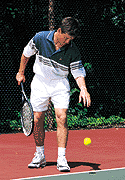 #6 Same as it ever was #6 Same as it ever was When you're practicing your serve, go through the same pre-serve rituals you use during a match. Bounce the ball a few times, bring your hands together, and then come to the set position. It doesn't matter if you hold your hands high or low, or how many times you bounce the ball; just do it the same way you would in a match, every time. The idea behind practice is to create consistency through repetition. If you don't practice your rituals, they won't be worth employing during a match. --Lynne Rolley |
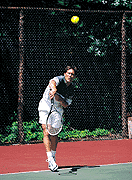 #7 Snap to it #7 Snap to it When snapping your wrist, it's important to get your racquet head through the impact point quickly. If your wrist leads the way, the frame will be late coming through and the ball is sure to go long. So remember to let the racquet head accelerate and overtake the hand and the wrist. --Dr. Jack Groppel |
| #8 Power plays Looking to add more power to your serve? Here are two things you need to do: 1. Stay relaxed. When
trying to hit the ball hard, club players tend to tighten
up. Try to keep both your arm and your hand loose. The one thing you can't afford to do is only use your arm. The whole body needs to be part of the service chain. --Tom Gullikson |
| #9 Mix, Match When you serve from the same spot on the court every time and hit to the same place -- and with an identical amount of pace and spin -- over and over, you become predictable. And the last thing any server wants to be is predictable. So the next time you serve, change where you stand, the amount of spin you put on the ball, how hard you hit it, and where you're aiming in the service box. The more you add in terms of variety, the more you'll keep your opponent off balance, forcing him to hit weak returns -- returns that can set up the rest of your game. And if you find a serve that's giving your opponent a particularly hard time, keep feeding it to him! --Stan Smith |
| HOW TO HOT-DOG |
| #10 Bow wow, Boom
Boom Boris Becker might be an old dog, but he does not need to learn new tricks. He long ago mastered the art of walking the dog, a skill he used for strutting back to the service line. 1. To make like Boris,
hold your racquet in an Eastern forehand grip and bounce
the ball in front of your dominant side (that's 2 o'clock
for a right-hander, 10 o'clock for a lefty). |
| #11 Professional advice
Todd Martin stands closer to the sidelines than most pros when he serves, for three very good reasons: 1. A sharper angle to go wide. "By standing farther out, you have a better angle to hit the ball wide off the court -- yet still maintain a significant amount of power," Martin says. 2. Better return coverage. "Since most returns go crosscourt, you're usually in good position for the next shot. Down-the-line winners off the service return are rare, so you're playing the percentages." 3. A higher margin for error. "Standing out wide lets you hit over the lower part of the net and gives you more court to serve into." |
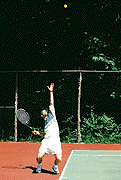 #12 Sitting pretty #12 Sitting pretty
Players trying to get more drive out of their legs when they serve should pretend they're sitting down as they toss the ball. (Don't worry -- you won't have enough time to go too low.) Then, just as you're ready to swing, explode up and into the ball. --Dr. Jack Groppel |
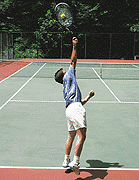 #13 Something to kick
around #13 Something to kick
around Developing a topspin serve, also known as a kick serve, is a smart way to make your second ball more consistent and less vulnerable to attack. Instead of a slice (most players' natural spin) that swings to the side, a serve that's struck with topspin not only gives your ball added net clearance, but it also makes it kick up after it bounces, thus taking the ball out of the returner's strike zone. Patrick Rafter is adept at using his kick serve to elicit awkward returns from his opponents. And because the ball moves more slowly through the air, it also gives Rafter more time to get into good volleying position. How to hit a topspin serve: Using an Eastern backhand grip, toss the ball more in front of your body than off to your dominant side. Arch your back and bend your knees. As you reach forward, make contact on the back side of the ball. (If the ball were a clock, hit it at 6 o'clock and brush up to 12 o'clock.) --Tom Gullikson |
| #14 It's a setup Control, disguise, and variation are more important than sheer pace when it comes to your serve. Using your serve to move an opponent off the court and set up the point is a basic tenet of tennis. One player who does this extremely well is Andre Agassi. He loves to hit a kick serve (which, compared to the flat serves of other pros, has less pace but more pop) to a right-hander's backhand in the ad court. The spin takes his opponent off the playing surface and mercilessly sets up Agassi's blistering crosscourt forehand on the next shot. --Nick Saviano |
| #15 The wrist is history
A loose wrist can salvage a lot of bad ball tosses and make your serve more effective. A wrist that's locked and firm will make it difficult for a player -- at any level -- to get spin on the ball, and it's the spin on your serve that will help you control the ball and maintain consistency. Additionally, a locked wrist will put you at risk of doing serious harm to your elbow. To make sure your wrist isn't too tight when you serve, always keep the pinkie finger, ring finger, and middle finger of your racquet hand relaxed. When these fingers tighten, your wrist locks automatically. --Peter Burwash |
Tennis Magazine's 101 tips: Return of serve
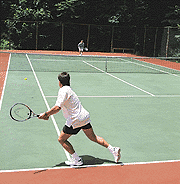 #16 Reactionary #16 Reactionary You've got no more than half a second to react to an opponent's first serve, so you'd better think -- and move -- fast! During warm-ups, if your opponent plunks a serve into the net, notice where your racquet is at that moment. If it's still in the ready position, chances are you would not have been ready for the shot. By the time the serve crosses the plane of the net, you've got to have the racquet back and on the proper side of your body. --Dennis Van der Meer |
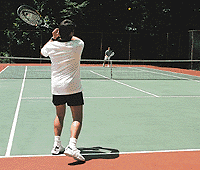 #17 Taking down the server #17 Taking down the server
On the return of serve, your goal should always be to neutralize your opponent. The higher the level of game, the more the server has the advantage, so try to keep the ball low or hit it deep. When you're facing a player who likes to serve and volley, a low return will force him to play a tough shot. If your opponent prefers to stay back, a deep return will drive him behind the baseline, and his chances of hurting you with ground strokes will be minimized. So when you have an opportunity to return a second serve, or if you're playing someone whose delivery lacks pace, focus on where you want your low or deep return to go; pinpoint placement is a bonus. --Peter Burwash |
| #18
Pound 'em with pressure Once you're able to get your opponent's serve back consistently, the next step is to gain directional control and see if you can keep the ball out of the middle of the court. Pressure the other guy's first serve, and more than likely his first-serve percentage will drop. Then you can bear down on the second serve and go for a few winners, which will compound the pressure your opponent is feeling. --Paul Annacone |
| #19
Two of a kind What kind of returner are you? Basically, there are two models: 1. The Andre Agassi type, who tries to grab control of the point and dictate play with the return. 2. The Pete Sampras type, who looks to get the return deep, work himself into the point, and optimize the rest of his game. Once you figure out which group you fall into, you'll be able to practice with a game plan. --Paul Annacone |
| #20
Beginner vs. beginner If you're a beginner, the other beginners you'll be playing will rarely serve and volley, so do what you can to hit a deep return. Stay down and get your shoulders turned quickly. Keeping the shot deep will trap your opponent at the baseline and allow you to come in and attack the net. --Tracy Austin |
| #21
Champions say yes Don't push the return at crucial times during a match. Champions learn how to hit out on the big points and move forward so that they can challenge the ball. --Nick Bollettieri |
| #22
Professional advice "Returning serve is a serious thing on grass and other fast surfaces because the ball seems like it's going to attach itself to you. So you have to take a shorter stroke and, if you can, move forward. I basically try to take a shorter stroke and cut down on my follow-through." --Venus Williams |
| #23
To have and to hold A common question that club players ask me is, "When I'm waiting to receive serve, how should I hold my racquet?" My answer: As long as you adjust your grip when you take your backswing, hold your racquet with any grip that feels comfortable. --Tom Gullikson |
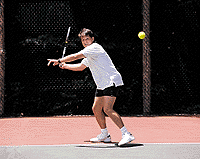 #24 Flaunt that forehand #24 Flaunt that forehand
When you're returning serve, practice running around your backhand. Stay in control of your body and try to get your momentum moving into the court, not toward the sideline. When done correctly, this move will devastate just about any opponent. --Dr. Jack Groppel |
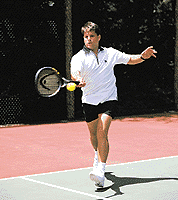 #25 hold that baseline #25 hold that baseline Don't stand too deep in the court. Whenever possible, force yourself to return serve from the baseline area or, if you can, from just inside the baseline. That way, you'll pick up the ball earlier and react with a purpose. --Nick Bollettieri |
| #26
Return engagement When it comes to returning serve, many players spend a lot of time reacting with their bodies and not enough time using their head. The best returners devise a plan for how they're going to handle each return ahead of time. It may be something as simple as "deep in my opponent's court" or something more sophisticated, like "down the line if it's a backhand and crosscourt if the serve is out wide to my forehand." Sound complicated? Maybe. But it's one way for you to begin controlling the destiny of a point before it even begins. --Stan Smith |
Tennis Magazine's 101 tips: Forehand
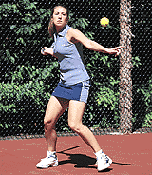 #27 A weighting game #27 A weighting game For a powerful forehand, load your weight onto your back leg. Then, after you get into the proper position, transfer your weight onto your left side as you start your swing, if you're a right-handed player, or transfer your weight onto your right side, if you're left-handed. By rotating your trunk, hips, and shoulders, you can play any type of forehand that you want -- a rally-paced shot, a powerful drive, or a stroke with heavy topspin. --Dennis Van der Meer |
| #28
Rocket science Having trouble hitting that topspin forehand? If you are, try "crowding" the ball (getting a little closer to it), which will shorten your reach and allow you to rotate your trunk. Rod Laver says he did this in pressure-filled situations. He would actually swing harder and at a more vertical angle, creating topspin to keep the ball in the court. --Dr. Jack Groppel |
| #29
At ease, shoulder Club players who hit from an open stance often fail to turn their shoulders, making it too easy to swing across the body. If you hit from an open stance, your directional control should not be coming from your hand, wrist, or elbow, but from your shoulder. The first step is to make a good upper-body turn, and then, when you uncoil your shoulders, swing out toward the target. That's where your control will come from. --Tom Gullikson |
| #30
Go Deep Keep the ball deep. I don't care how hard you hit it, just keep it deep! Power without depth is no good. Power with depth and consistency is the ultimate goal. --Nick Bollettieri |
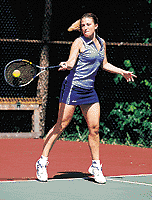 #31 No arm done #31 No arm done Never stand completely sideways to the net when you hit your forehand. What you want is a slightly open stance, one that allows your hips to turn and release into the shot. This will help you generate more power using big muscles like your legs, hips, and shoulders, not just your arm! --Paul Annacone |
| #32
Professional advice Some players make loopy backswings, use extreme grips, and hit everything with a lot of topspin. But not Steffi Graf. Graf takes a flatter backswing and, as a result, doesn't have to make major stroke realignments going from one surface to the next. "I don't have trouble adjusting to faster courts," she says. "Sometimes it's difficult if the ball comes flat, but I like that my forehand is suited for this easy adjustment." Suited? Graf has won each Grand Slam at least four times! |
| #33
Go Western, young man As you learn to hit your forehand, you also need to understand the relationship between your grip and your stance. In the days of wood racquets, players had to step forward toward their target in order to generate power on their forehand. To do this, they used the traditional Eastern forehand grip and a flat swing. But with the development of oversize heads and lighter racquets, players today can easily brush up the back of the ball to create topspin. Because of this, semi-Western and Western grips are now more popular. These grips require you to hit from a relatively open stance, with your nondominant foot stepping to the side. The more extreme your grip (the more the base knuckle of your index finger goes under the handle), the more open your stance will be. Pete Sampras, who uses a semi-Western grip, steps ever-so-slightly forward, while a player like Jim Courier, who hits with a full Western grip, steps to the side and is more open to the court. Then there's clay-court expert Alberto Berasategui, who has one of the most extreme forehand grips in history; his hips and shoulders are completely open to the court. --Stan Smith |
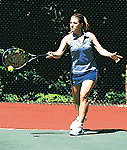 (1) (1)
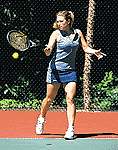 (2) (2) 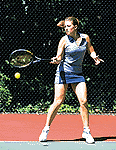 (3) (3)If you hit with an Eastern grip, step toward the target (1); A semi-Western grip requires more of an open stance (2); Western-grip players will be totally open-stanced (3). |
| #34
Whip it good Compare Steffi Graf's forehand with Andre Agassi's and Jim Courier's and you'll notice that they have their own grips and stances, but all three generate tremendous racquet-head speed and power. By cocking their wrists and getting their racquet heads up during their backswings, the three champions create a whip-like action as they rotate their shoulders and make their swings. Similarly, the faster you can swing -- or whip -- your racquet through the hitting zone, the more power you'll get on the forehand. --Lynne Rolley |
| #35
The inside (out) story The inside-out forehand, a shot that a right-hander hits crosscourt from the ad court and lefties hit crosscourt from the deuce court, was popularized by Steffi Graf and Jim Courier. It's been a key to success in the power game of the 1990s. When your opponent's shot lands in the middle of the court, run around your backhand and hit a forehand to his ad court (assuming you're both right-handed). This will pull him off the court and force him to hit a defensive backhand, which will probably go down the line or toward the center of the court. From there, you should have a clear crosscourt forehand for your next shot. --Nick Saviano |
| K I L L E R C A M P D R I L L |
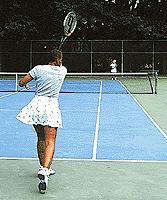 #36
Right Up Your Alley #36
Right Up Your Alley Ramey Tennis School, Owensboro, Ky. The power that today's bionic racquets generate is useless without accuracy. This cooperative drill is great for teaching control, timing, and proper technique to developing players. Stand in a doubles alley along your baseline, drop a ball, and hit a forehand the length of the alley to your practice partner. Your partner should hit a forehand in return, again keeping the ball in the alley. Continue to play out the point, hitting nothing but forehands that stay in the doubles alley. This drill is about consistency, concentration, and control. With practice, you should develop a steady forehand that can become the foundation of your baseline game. --Joan Ramey, director of tennis |
| #37
(Take it on the) Rise and shine In today's power game, you have to be aggressive, take the ball early, and unload big forehands whenever you get the chance. This drill is designed to improve your on-the-rise forehand. Rally with your practice partner, hitting nothing but forehands crosscourt (him) and down the line (you). To make the drill more challenging, you must stand inside the baseline at all times. After a few minutes, switch, with you going crosscourt and your partner practicing his down-the-line shots. This drill will
help you to recognize opportunities for attack, and it
will also show you how to control the middle of the court
while you hone the |
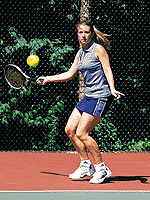 #38 Ready when you are #38 Ready when you are Whenever possible, prepare to hit your forehand while your opponent's shot is in the air. Why? Because by the time his shot hits the ground on your side of the net, your racquet will be back all the way, your shoulders locked and loaded. Also, remember to move your body at an angle that permits you to make a play on the ball before it gets too wide and pulls you off the court entirely. --Brian Gottfried |
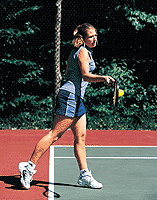 #39 Depth wish #39 Depth wish On TV, players seem to whip their racquets around their body on the forehand side. Why is this? Because their opponents hit with so much pace, pros can afford to use lots of topspin and not drive all the way through their shots. But at the club level, you'll rarely face anyone who'll supply this kind of power. Try to emulate this wrap-around move and your forehand will probably land short. To get the ball deep in the court, you have to drive it. This means staying with your forehand through the hitting zone, which is 12 to 18 inches in front of your contact point. --Tracy Austin |
| HOW TO HOT-DOG |
| #40
Winner with Andre The next time your opponent lobs, you could run it down and hit a garden-variety ground stroke. Or you could take a page out of Andre Agassi's playbook and whip the ball back over your shoulder. Here's how: 1. As soon as the
lob goes up, turn around (so that you're facing the back
fence) and run. Let the ball bounce, and position
yourself so that it will come up over the shoulder of
your nondominant side. |
Tennis Magazine's 101 tips: Backhand
| #41
A hip thing not to do Going down the line? One-handers shouldn't open their hips up too early. This will pull the shot too far inside the court. --Dennis Van der Meer |
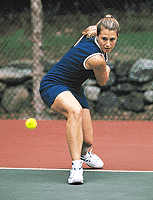 #42 How low can you go? #42 How low can you go?
When I teach clinics and tell people they need to get lower and bend their knees if they want to hit a solid topspin backhand, they bend about an inch and think that's getting down. Then, when the low ball comes, they're forced to scoop at it, which opens the racquet face and sends the shot long. To hit an effective topspin backhand, you have to get your body down and, with a closed racquet face, swing from low to high. --Tracy Austin |
| #43
Limited edition If your backhand is your weaker side, my advice is to know your limits. Stay within your rally speed and find your swing tempo. Look at Pete Sampras and Tommy Haas: They stay within their limits on the backhand --using angles and slice --and wait for a chance to run around and hit a forehand. --Nick Bollettieri |
| #44
You name it As you prepare to hit a backhand, pretend that your name is written on your back. Then, as you prepare to hit, rotate enough so that your opponent is able to read it. --Dr. Jack Groppel |
| #45
Turn, turn, turn On your backhand, instead of thinking about taking your racquet back, turn your body sideways instead. This will automatically put your racquet in the right spot. --Brian Gottfried |
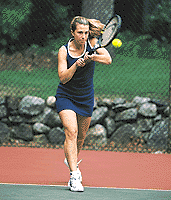 #46 A Real no-brainer #46 A Real no-brainer Too many club-level players worry about their backhand. Relax! Instead of bemoaning the fact that you can't cream your backhand like you can your forehand, learn to hit a good, neutralizing backhand (either a high or low shot that stays out of the opponent's power zone). If all you can hit is a slice backhand, that's fine. Just develop a low slice that forces your opponent to reach outside his strike zone. Lack power on your topspin backhand? Come up with a shot that loops high and forces your opponent to move back and hit from an awkward position. These kinds of strokes won't generate many winners, but they won't be crushed by the other guy either. And that's all you really need from a backhand. --Nick Saviano |
| #47
Going to extremes It's OK for players who have extreme one-handed backhand grips to follow through in nontraditional positions. Gustavo Kuerten and Conchita Martinez, for example, go past the standard Eastern grip (base knuckle of the index finger on the top panel of the racquet) and place it farther behind the handle. Thus, their racquet face points slightly downward. Only after making an exaggerated low-to-high swing do these players open their shoulders to the court. This shot takes great timing, but the rewards are in the results. --Stan Smith |
| #48
Two-hand touch Coaches have widely differing opinions regarding hand placement on a two-handed backhand. Personally, I think that players who hit with two hands should use a Continental grip with the dominant hand and an Eastern forehand or semi-Western forehand grip with their nondominant hand. Need convincing? Chris Evert, Bjorn Borg, and Andre Agassi all use this grip combination. While your nondominant hand drives forward and gives your shot its power, your dominant hand helps put spin on the ball. Warning: Don't slide your nondominant hand toward a Continental grip; this will cause the racquet face to open up and keep you from getting enough spin on the ball to bring it down into the court. --Lynne Rolley |
| K I L L E R C A M P D R I L L |
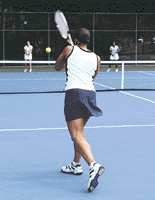 #49 The drill of victory #49 The drill of victory
Harry Hopman Tennis at Saddlebrook resort, Wesley Chapel, Fla. The forehand gets all the glory, but the higher you move up the club ladder, the more you'll want to attack and defend using your forehand and backhand. This drill will improve your backhand approach shots and putaways, while also teaching you how to play defensively and recover by using your backhand. With two players standing on the baseline across the net, start by dropping a ball and hitting a backhand. The players on the other side should keep pounding the ball to your backhand side. When they hit a short ball, respond with an angled backhand, a slice backhand approach, or a down-the-line backhand, and then rush the net. Try to finish the point off with a volley; as soon as the point is over, a baseline player should throw up a high ball to your backhand side. Recover toward the baseline, let it bounce, and start the next rally. After three minutes, switch positions. --Curly Davis, director of tennis |
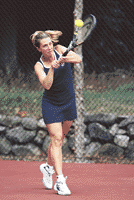 #50 Keep your distance #50 Keep your distance Have trouble playing shoulder-high backhands? It's all in the spacing. Get too close to a high ball and you'll have to bend your arm to make contact, resulting in a crippled shot. The farther away from the ball you are, the more relaxed your swing will be -- and the better you'll hit. --Dennis Van der Meer |
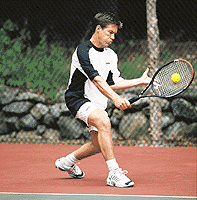 #51 Little chop of horrors #51 Little chop of horrors
A slice backhand should be hit like a volley --punching or driving out and through the ball with a slightly open racquet face. No chopping down is allowed. --Paul Annacone |
| #52
Shoulder the load On a two-handed backhand, don't drive the racquet with your hands. This can cause excessive wrist action and loss of control. Instead, think of driving the ball with your shoulders. --Dr. Jack Groppel |
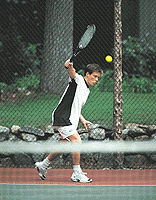 #53 On the edge #53 On the edge When hitting down-the-line backhands, keep in mind two things: 1. Your contact point should be just a bit farther back in your stance than it would be if you were going crosscourt. 2. Hitting around the outside edge of the ball will help you bring the shot back into the court. --Tom Gullikson |
| #54
Target practice If you hit your backhand with one hand, think of your front shoulder (the right shoulder for a right-handed player, the left shoulder for a left-hander) as your directional pointer. Pretend there's a line between your two shoulders; as your body shifts around, fix the front shoulder so that it's pointing in the direction of the intended stroke, and then accelerate the racquet arm toward impact. --Dr. Jack Groppel |
| HOW TO HOT-DOG |
| #55
Pick it up Bending over to get a tennis ball involves many perils. To wit: Guys risk splitting their shorts and gals leave themselves open to a panty shot. But fear not, because there are three ways to grab the ball without grabbing any unwanted attention. 1. With a loose wrist, tap
the ball with the top of the string bed, and then quickly
get the racquet out of the way so that the ball can
bounce. Then give it another tap. Keep doing this until
you gain control of the ball. |
Tennis Magazines 101 tips: Volley
| #56
Your turn For players who hit a two-handed backhand from the baseline, turning sideways and hitting a one-handed backhand volley can feel exceedingly awkward. But just like when they hit a down-the-line approach shot or a slice backhand ground stroke, players have to focus on turning completely sideways when they hit a two-handed backhand volley. If not, they won't expose a large enough hitting area to the ball, their wrists will be in a weakened position, and nearly every shot will pull to their dominant side, making their strokes extremely predictable. --Lynne Rolley |
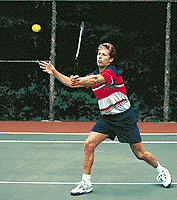 #57 The swing ain't the thing #57 The swing ain't the thing
To generate pace and power on your volley, avoid the temptation to take a big swing at the ball. Instead, turn the pace of your opponent's shot against him. Also, you'll get more pop on your volley if you utilize the muscles in your legs and hips as you step into the ball. And your racquet should not move very much. The best volleyers --Tim Henman, for example?ˇmake short punches and blocks. --Paul Annacone |
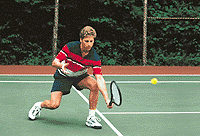 #58 Knee-deep in strategy #58 Knee-deep in strategy
The key to hitting good half-volleys (shots you pick up at mid-court) is bending your back knee. That way, you'll be able to get down to the ball without doubling over at your waist. Plus, keeping your back straight and transferring your weight forward will make it easier to get the return deep in your opponent's court. Pete Sampras is an excellent role model for this shot. --Tom Gullikson |
| #59
Ever-ready Even some of the experienced players I see at my club have poor ready positions, and because of that, they can't react quickly to many volleys. They allow their hands and racquet to hang low and they stand flat-footed at the net. Maybe they think the ready position isn't a big deal, but it is. You've got to be prepared to pounce, with your hands at chest level in front of your body and your weight slightly forward. Patrick Rafter and Jana Novotna are great players to emulate. To bring home the importance of getting into a solid ready position, stand along your service line and face your partner as he stands on his service line. Start volleying to each other, and try to keep the rally going. After each hit, take a small step forward and assume the ready position. You'll have to react quickly, and as the two of you close in on the net, it will become more difficult to volley if you let your racquet sag to waist level. --Tracy Austin |
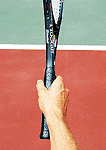 #60 Get a grip #60 Get a grip Many teachers believe that beginners should alter their grips on forehand and backhand volleys to make the shots more solid. But when it comes to the volley, the Continental grip (right), where the base knuckle of your index finger goes along the top right bevel (if you're a right-hander) or top left bevel (if you're a lefty), is the best for players of all levels. The Continental grip is the only one that lets you set your wrist firmly and hit with a slightly open racquet face off both forehand and backhand. And switching your grip once you're used to other grips on the volley can be a frustrating experience. --Peter Burwash |
| #61Volleying
101 At volley practice, keep two variations in mind: a deep, penetrating volley and a short, angled volley. They're all you'll ever need! --Dr. Jack Groppel |
| #62Split
decision If you hit an excellent serve or a perfect approach shot and see your opponent beginning to lunge at the ball, there's no need to split-step. Their reply is likely to be a weak one. Just rush in and finish off the point. --Dr. Jack Groppel |
| #63
Foot soldiers Stefan Edberg, one of the game's greatest volleyers, used to say that 90 percent of his net play was done with his feet, not his racquet. In other words: Make sure you're moving to the ball, not waiting for it to come to you. --Brian Gottfried |
| K I L L E R C A M P D R I L L |
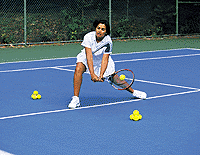 #64 Thighs and
lows #64 Thighs and
lows Billy stearns tennis center, Sarasota, Fla. When you hit a volley, your legs --and your thigh muscles, in particular?ˇhave to be involved. This drill, which we do with top juniors, aspiring tour players, and adult campers, teaches you to hit low volleys by bending your knees (instead of your waist) and reinforces the idea of moving forward to cut down your opponent's passing-shot angles. It'll also have your thighs screaming! Begin by making two small piles of tennis balls about 5 feet back from the net and 5 feet away from the center service line. Starting from the convergence of service lines (otherwise known as the T), have a feeder hit alternating low forehand and backhand volleys to you. As you move forward and hit the shots, keep your back straight and bend with your knees. As soon as you've completed the shot, reach down, grab a ball from the pile, and quickly bring it back to the T. Remember to continue volleying until all the piles are cleared away. Again: Don't bend at the waist. Use your legs and thighs to get down to each volley. Beginners may want to start out with three- or four-ball piles, while experienced players should feel free to put up to 12 balls in each pile. Don't get careless and reach for a ball before you make contact. Watch the shot come to you, make the hit, and then grab for the ball. --Billy Stearns, director of tennis |
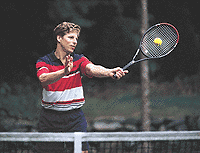 #65 The handyman can #65 The handyman can When you volley -- both forehand and backhand -- your first move should be to set your hand in the correct position to hit. So even if there's no time to make a textbook shot, you'll still have a play on the ball. --Dennis Van der Meer |
| HOW TO HOT-DOG |
| #66
Catch cradle It's the essence of tennis cool, a move so sweet, you probably thought only a pro could pull it off. But no! Now you, too, can catch the ball with your racquet strings. Here's how: 1. As the ball approaches,
extend your arm fully so that the face of the racquet is
perpendicular to the ground and your hand is in a
Continental grip. |
| #67
Professional advice "Try to get down to the level of the ball. That's probably the best tip I can give a volleyer. That's basically what I try to do," says Patrick Rafter, the 1997 and '98 U.S. Open champion. When your volleys start letting you down, you won't find any shortcuts to fixing them. "Go back onto the court," Rafter says, "and keep working hard until you get the feel and touch of it again." |
| #68
Soft hands, hard volley One of the keys to hitting effective volleys is controlling your racquet head and keeping your dominant hand relaxed. Master these two things and you'll have a greater sense of feel and precision around the net. To practice keeping your hand relaxed, have a coach or feeder hit you a series of volleys. Just before you make contact, have the feeder call out where he wants you to volley: "deep" for a ball near the baseline, or "drop" for a drop volley. Given enough practice, you'll approach all volleys with a more relaxed hand and become a more versatile, well-rounded volleyer with a better sense of touch. --Stan Smith |
| #69
A little stab will do ya When you're at the net and need to make a stab at a passing shot, it's a good idea to cut the ball off by moving slightly forward. This will give you a bit of momentum, and you won't have to swing as forcefully to hit the shot. Also, be sure to keep your upper body under control as you start to volley. --Dr. Jack Groppel |
Tennis Magazine's 101 tips: Overhead
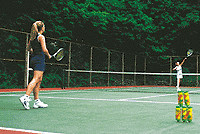 #70 Pick your spot #70 Pick your spot One of the most difficult aspects of hitting an overhead --even a sitting-duck overhead -- is picking a spot in your opponent's court to direct the shot. To ensure that you never miss an overhead due to this location dilemma, you should learn to hit it from anywhere in your court to a specific spot in the other court. Options? Angle your smash to the deuce or ad corner, or hit deep and down the middle. But no matter where you're forced to hit your overhead, there should be one spot you can consistently hit to and know you'll make it. When in doubt, go to that favorite spot. An easy winner should never end up being a point for your opponent. --Lynne Rolley |
| #71
Made in the shade A bright sun can make hitting overheads a brutal undertaking. Here are two ways to make this shot more manageable. 1.
Wear sunglasses. Most professional players don't wear
them when they play on a sunny day, but sunglasses will
eliminate &auotthe squints" and allow you to see
the ball more clearly. A hat, which is becoming more and
more popular among tour players, is another good way to
shade your eyes. |
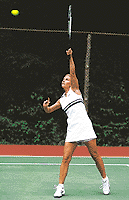 #72 Are you up to it? #72 Are you up to it? When hitting overheads, some players drop their head and their eyes. This is a nasty habit to get into because it can start a chain reaction: First the head comes down, then you stop watching the ball, then your shoulders automatically come down, and finally, your overhead ends up in the net. Too many club players are concerned with clobbering their overheads. The bottom line is, you've got to play within your abilities. To hit an effective
overhead, keep your head and eyes up and strive for full
extension as you reach for the ball. Let your racquet
head generate the speed. And remember: If you're forced
to hit from an awkward position, take some pace off the
shot and |
| HOW TO HOT-DOG |
| #73
When all else flails No one had ever seen anything like it -- until Jimmy Connors came along. It was so mechanical, so stiff, so awkward-looking, it couldn't possibly go over the net. But that didn't stop Jimbo from hitting his patented skyhook overhead for a winner just about every chance he got. Use the skyhook only when you don't have enough time to set up for a traditional overhead. If you've got to hit it, here's how: 1.-2. From the ready
position, turn sideways and get your racquet arm fully
extended and pointing toward the back fence. |
Tennis Magazine's 101 tips: Singles strategy
| #74
All-court, all the time In some ways, being a multidimensional player can be a liability. If you're trying to develop an all-court game, it takes a little time to learn what shots to hit and when, so be patient. Pros like Andre Agassi and Mary Pierce are one-dimensional. When they play matches on different surfaces and against different opponents, they don't change their games much, whereas an all-court player like Pete Sampras has to work through an inner argument: When you have all the shots, you have to learn when, and how, to use them effectively based on the surface and your adversary. And so it is that all-court players tend to develop more slowly. Most prodigies are one-dimensional players; they can nail ball after ball from the baseline, but that's about it. To develop fully takes time, so think long-term and keep practicing. --Paul Annacone |
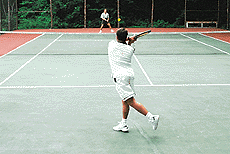 #75 Be self-centered #75 Be self-centered There's only one strategy that really matters in singles: Control the center of the court! By hitting aggressive shots that give you enough time to recover into the middle of the court (or pretty close to it), you won't let your opponent win points with easy shots. Work on your crosscourt patterns, develop your consistency and movement skills, and attack the net after hitting down the line. By understanding the geometry of the court and playing the percentages, you'll force the other guy to hit tough shots in order to beat you. And at the club level, that's not going to happen very often. --Nick Bollettieri |
| #76
I gotta be me Your game should reflect your personality. If you're the strong, aggressive type, you ought to have a bold, attacking game. Without it, the sport won't be as much fun, and you'll constantly be working against your instincts. Can you imagine someone like Boris Becker playing roadrunner tennis? It just wouldn't fit with his bigger-than-life persona. In contrast, if you have a passive personality, your game should be more wait-and-see?oriented. Forcing the issue and taking command won't feel right to you, and that's OK. Michael Chang's thoughtful, patient game is a great example of a style matching a player's personality. --Nick Saviano |
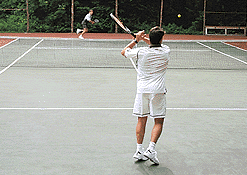 #77 Open wide #77 Open wide Against players who don't move well or who anticipate poorly, use a lot of topspin or slice on your shots. Why? If the shots are placed well, you can pull your opponent wide and set up to hit your next shot into the open court. Andre Agassi, Martina Hingis, and Monica Seles all have used this tactic to reach No. 1. --Stan Smith |
| #78
Surface purpose You have to respect the surface you're playing on. Think about what the court gives your game (in other words, what it amplifies) and what it takes away. Yes, some surfaces may be more kind to you than others, but baseliners can win on fast surfaces and serve-and-volleyers can be successful on clay. With a few minor adjustments and some forethought, you can make your best shots work for you. Bjorn Borg proved this by using his solid baseline game to win the French Open on red clay and Wimbledon on green grass back-to-back . . . three times! --Tom Gullikson |
| #79
Tip the court in your favor Shot selection -- knowing when to hit a shot -- can be a tricky business. But a philosophy that has worked well for Pete Sampras, the player I coach, is: Try to make your opponent's court seem very big and your own court very small. Here's how: 1. The farther behind the
baseline you are, the more net clearance your shot should
have in order to ensure that the ball goes deep.
Lower-trajectory shots may be glamorous and exciting, but
they often land short, and remember, your main objective
is to pin the opponent as far back on the court as
possible, where he can't do much damage. You, on the other hand, probably need to be inside the baseline to pound a ball past an opponent. --Paul Annacone |
| #80
The rating game Assess your strengths and weaknesses regularly. Then, based on what you know you can do, play a style that puts you in position to hit your best shots and also minimizes your weak points. If you have a strong forehand but a poor net game, pressure your opponent from the baseline and come forward only to hit easy volleys. If you have a good lob and solid passing shots, lure your opponent into net --then take advantage of your strengths. --Lynne Rolley |
| #81
Professional advice Knowing when to play it safe and when to go for it is a secret to playing well. So says Pete Sampras, the six-time Wimbledon champion: "The key is finding the right opportunity to break and applying constant pressure. At 3-3 or 4-4 in a match is the time you need to raise your game a level. It's recognizing the opportunity and, hopefully, converting." Sampras takes many factors into account when deciding how aggressively he needs to play: "I look at the score; I look at where he's serving; I look at how he's winning his points and how I'm winning my points." It should go without saying: Stick with what's working for you, even though it may not be your favorite play. |
| #82
Sounds like a plan It's so basic, but so few players do it. What is it? Think tactically. The first few games of a match should be spent picking out your opponent's weaknesses. Notice if he likes to run around his backhand and hit forehands -- a tip that he may have a weak backhand. If he nets a lot of overheads in the warm-up, remember to lob. Playing doubles? Talk to your partner, compare what the two of you have observed, and formulate a strategy. When I watch friends play their league matches, they often serve to the same spot on the court because they like to serve there, regardless of who they're playing. They toss the ball up without thinking, OK, she's missed two forehands in a row, let's try making it three, or, I'm going to hit with a little slice because that seems to bother her. Champions don't feed their opponents the shots they like to hit. --Tracy Austin |
| HOW TO HOT-DOG |
| #83
Betwixt and between First popularized by the flashy Frenchman Yannick Noah and, later, Gabriela Sabatini, the 'Saba-tweeny' requires tremendous coordination and perfect timing. (Kids --get a parent's OK first.) Here's how to hit it: 1. Once your opponent throws
up a lob, turn around, face the back fence, and run. As
the ball is about to bounce in front of you, cock your
racquet high over your head (making sure to use an
Eastern forehand grip and keeping a loose wrist). Let the
ball bounce in front of you. |
| K I L L E R C A M P D R I L L |
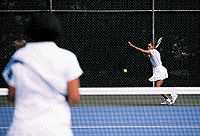 #84 Forehand frenzy #84 Forehand frenzy Nike Tennis Camp, Santa Cruz, Calif. The modern game is all about movement, power, and using your best shots as often as you can. For most players, that means hitting lots of forehands. This drill will get you to practice the footwork patterns you'll need to crack one forehand after another. Start from the center of your baseline. Have a feeder hit a loopy shot to your backhand. Run around the backhand and hit an inside-out forehand crosscourt. As you recover, the feeder should hit another shot, this time to your natural forehand side. Return this ball crosscourt as well. Continue the drill, with the feeder mixing up the location of the feeds. You should run around your backhand every chance you get and hit nothing but crosscourt forehands. Beginners may want
to set a personal goal of making five to seven shots in a
row. Intermediates should try to make as many shots out
of 20 as they can. Advanced players ought to hit as
|
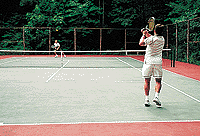 #85 Crosscourt rules #85 Crosscourt rules During a rally, nearly all of your shots should go crosscourt (the exception: approach shots). You no doubt know that the net is lower over the middle and the court is longer. What you may not realize is that going crosscourt allows you to recover to the ideal position on the court faster. Imagine you're rallying, and your opponent hits a ball deep to your forehand. If you return down the line, you'll need to recover --not just to the center of the court, but a few feet past center (because your opponent's easiest shot is crosscourt to your backhand). If, in that same situation, you go crosscourt, you need only recover to within a few feet of the center mark, hedging just a bit to your forehand side. Again, your opponent's highest-percentage shot is crosscourt, but you'll already be in the right spot. Remember: The player who hits down the line first in a rally usually has to do more of the running. --Stan Smith |
| #86
The eyes have it You should watch your opponent play at least twice to get a feel for the type of game he has. And I don't mean letting your coach watch him or listening to what the guys in the locker room have to say. You should go see him play a match. The difference between hearsay and what your eyes see? You're the one who has to play this person, so you should know firsthand what to do. You can then use the pre-match warm-up to test out the things you've observed. --Brian Gottfried |
| #87
It's a big court -- use it From the center mark along your baseline, it'll take about three or four steps to reach most of your opponent's ground strokes. But it'll take you nine or 10 steps to reach the ball if your opponent hits a drop shot. So instead of just hitting the ball back and forth, every stroke you make should have a purpose and take advantage of the entire court. Make sure your opponent is forced to cover every inch of territory, not just the baseline. --Peter Burwash |
| #88
Going for the goal Players -- on the pro tour as well as the local club circuit -- will often judge how they've performed based solely on whether they've won or lost a particular match. You have to get past this and look at the quality of your play, not the outcome. If you set a goal of playing at a certain level, then achieve it and still lose, your opponent was simply too good. Focus on how well you're executing your game plan. And instead of thinking, I can't believe I'm losing love-4, ask yourself, OK, it's love-4, am I making him hit lots of backhands, like I wanted to going into the match? Probably not. Therein lies the problem -- and the solution. --Paul Annacone |
Tennis Magazine's 101 tips: Doubles strategy
| #89
To play's the thing Championship teams live for the moments when matches are tight and the heat of the battle is most intense. You should, too. Think about it: Where would you rather be? Winning a close match with your partner by your side is one of the most gratifying feelings an athlete can have. But to win, you have to be in a tight match in the first place. If all your matches were easy, the sport wouldn't be challenging, and meeting a challenge head on is why we play the game. --Lynne Rolley |
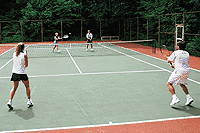 #90 Middle management #90 Middle management The single biggest difference between social and competitive doubles is in the positioning. The social team splits itself wide and protects the alleys, leaving the middle of the court open. The competitive team closes off the middle and lures the opposition into gunning for the lines. Moving to a more central position at the net and covering the middle will directly impact the way your opponents play the game. --Nick Bollettieri |
| #91
moving without the ball When you see that the ball is heading toward your partner, you should move in whichever direction will improve your position. After all, there's nothing in the rule book that says you have to stay in the same spot on the court all the time. --Dennis Van der Meer |
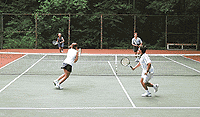 #92 Yours, truly #92 Yours, truly If a player who's been lobbed over can't retreat and have a reasonable shot at a smash, he should switch to the other side of the court and let his partner cross behind him to play the ball. "Switching," as this maneuver is called, is important because the player who's running back to retrieve the lob at an angle has a better chance at making a good hit than the player who's back-pedaling. A player who's running at an angle might also be able to sneak a peek at what the other team is doing, and thus have a feel for the kind of shot he needs to hit. --Tom Gullikson |
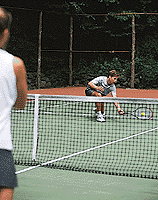 #93 Save, and a beauty #93 Save, and a beauty You're the receiver's partner. That puts you in the hot seat, the toughest position on a doubles court. And while it's true that you're going to miss some reflex volleys, you can easily redeem yourself: By saving just one shot, you can make a big difference in a match. To quicken your reactions and sharpen your instincts, have a practice partner stand at the net and hit shots to you along the service line. No one will get to all of them, but by staying low, keeping your racquet in front of your body, and remaining alert, you'll be surprised at how many more shots you'll be able to save. --Dennis Van der Meer |
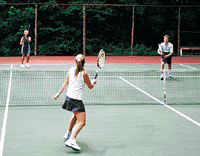 #94 Variety show #94 Variety show Unpredictability adds drama to a doubles match. Plant a seed early in your opponents' minds that you won't do the same things over and over. Poach on a few of the opening points, hit a lob return, go down the alley, alter your service positions. Show a bit of variety in the first couple of games and your opponents won't know what to expect as the match progresses. --Stan Smith |
| #95
After you. No, after you. Here are two intelligent ways to decide who should serve first in doubles: 1. Consider the elements.
Depending on the time of day, the sun may be shining into
one player's eyes. Serve from the side where the sun is
less of a limiting factor. |
| K I L L E R C A M P D R I L L |
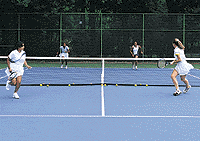 #96 Don't be meek in
retreat #96 Don't be meek in
retreat Total Tennis, Saugerties, N.Y. Learning how to recover and play sound defensive doubles is as important as learning how to play aggressive, in-your-face, finish-the-point doubles. But when was the last time you practiced hitting lobs and passing shots? That long, huh? This drill will change that. Place five tennis balls against each side of the net. With your team starting at the baseline and the other assuming positions at net, drop a ball and let the baseliner begin a rally. If the team that starts at net wins the rally, one point is added to their score. Then, that team quickly grabs another ball and gets the next rally going. If the team at the baseline wins, its players need to sprint to the net, grab a ball, and start a point as the other team retreats to its baseline. To earn a point, you must win a rally starting from the net. The first team to 15 points wins. --Craig Carpenter, head professional |
| #97
Lose the frown The goal is to win, and to win you've got to remain positive at all times. This goes for you and your partner. Scowling after he misses a volley or dropping your shoulders following a double fault isn't going to make him feel very good about himself or encourage him to play better tennis. Stay upbeat! --Tracy Austin |
| #98
Good vibrations To play winning doubles, personalities must mesh. That was one of the big factors in my brother John and I winning the Wimbledon mixed doubles title in 1980. He was always so positive, and when I got down about something, he was on it right away. Look at Natasha Zvereva and Gigi Fernandez. Gigi was the volatile one, Natasha remained calm, and together they won 14 Grand Slam titles. It's the same with Mark Woodforde and Todd Woodbridge. Opposites can attract -- and win. --Tracy Austin |
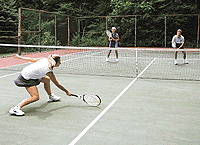 #99 Is there a doctor in the
house? #99 Is there a doctor in the
house? One of the best -- and least obvious -- approaches to doubles is to play in a way that protects your partner. From research I've done, I've found that about 80 percent of all tennis injuries occur on the doubles court. The situation that endangers your partner the most is when your opponents are about to make mincemeat of a high volley or overhead smash, and your partner doesn't realize that he's in the line of fire. What can you do to protect him? Concentrate on keeping the ball low. By forcing net players to volley up, your partner won't have to worry about poachers using him for target practice. Also, communicate with your partner by saying things like, 'Back up! The lob is short.' Again, this will give him a chance to get out of harm's (and the overheads) way. --Peter Burwash |
| #100
The pairs competition When it comes to finding a partner, here are two things to keep in mind. First, play with people who love doubles as much as you do. Some players prefer singles and head to the doubles court only as a last resort. You want your partner to be as excited about playing and creating a good team as you are. Second, get a partner whose game complements your own. If, for example, you have a weak serve, look for a player who loves to poach; this will take some of the pressure off your service game. If you have particularly strong volleys and overheads, you need a partner who can consistently hit returns that'll set up your net play. If you're the excitable type (maybe too excitable), find a partner who'll stay calm and keep your head in the game. --Brian Gottfried |
| HOW TO HOT-DOG |
| #101
The swinging volley Fifteen years ago, there was no such thing on the professional tour as a swinging volley. But thanks to baseline bashers like Andre Agassi and Monica Seles, itÝs become a viable option for players who don't particularly enjoy coming to the net. . . . And it's not as tough as you think. 1. Off the forehand side,
holding your racquet with a semi-Western or Western
forehand grip, try to play the ball at shoulder
level. |
Tennis Magazine's 101 tips: Killer Camp Drills
Forehand
| K I L L E R C A M P D R I L L |
 #36
Right Up Your Alley #36
Right Up Your Alley Ramey Tennis School, Owensboro, Ky. The power that today's bionic racquets generate is useless without accuracy. This cooperative drill is great for teaching control, timing, and proper technique to developing players. Stand in a doubles alley along your baseline, drop a ball, and hit a forehand the length of the alley to your practice partner. Your partner should hit a forehand in return, again keeping the ball in the alley. Continue to play out the point, hitting nothing but forehands that stay in the doubles alley. This drill is about consistency, concentration, and control. With practice, you should develop a steady forehand that can become the foundation of your baseline game. --Joan Ramey, director of tennis |
Backhand
| K I L L E R C A M P D R I L L |
 #49 The drill of victory #49 The drill of victory
Harry Hopman Tennis at Saddlebrook resort, Wesley Chapel, Fla. The forehand gets all the glory, but the higher you move up the club ladder, the more you'll want to attack and defend using your forehand and backhand. This drill will improve your backhand approach shots and putaways, while also teaching you how to play defensively and recover by using your backhand. With two players standing on the baseline across the net, start by dropping a ball and hitting a backhand. The players on the other side should keep pounding the ball to your backhand side. When they hit a short ball, respond with an angled backhand, a slice backhand approach, or a down-the-line backhand, and then rush the net. Try to finish the point off with a volley; as soon as the point is over, a baseline player should throw up a high ball to your backhand side. Recover toward the baseline, let it bounce, and start the next rally. After three minutes, switch positions. --Curly Davis, director of tennis |
Volley
| K I L L E R C A M P D R I L L |
 #64 Thighs and
lows #64 Thighs and
lows Billy stearns tennis center, Sarasota, Fla. When you hit a volley, your legs --and your thigh muscles, in particular?ˇhave to be involved. This drill, which we do with top juniors, aspiring tour players, and adult campers, teaches you to hit low volleys by bending your knees (instead of your waist) and reinforces the idea of moving forward to cut down your opponent's passing-shot angles. It'll also have your thighs screaming! Begin by making two small piles of tennis balls about 5 feet back from the net and 5 feet away from the center service line. Starting from the convergence of service lines (otherwise known as the T), have a feeder hit alternating low forehand and backhand volleys to you. As you move forward and hit the shots, keep your back straight and bend with your knees. As soon as you've completed the shot, reach down, grab a ball from the pile, and quickly bring it back to the T. Remember to continue volleying until all the piles are cleared away. Again: Don't bend at the waist. Use your legs and thighs to get down to each volley. Beginners may want to start out with three- or four-ball piles, while experienced players should feel free to put up to 12 balls in each pile. Don't get careless and reach for a ball before you make contact. Watch the shot come to you, make the hit, and then grab for the ball. --Billy Stearns, director of tennis |
Singles
| K I L L E R C A M P D R I L L |
 #84 Forehand frenzy #84 Forehand frenzy Nike Tennis Camp, Santa Cruz, Calif. The modern game is all about movement, power, and using your best shots as often as you can. For most players, that means hitting lots of forehands. This drill will get you to practice the footwork patterns you'll need to crack one forehand after another. Start from the center of your baseline. Have a feeder hit a loopy shot to your backhand. Run around the backhand and hit an inside-out forehand crosscourt. As you recover, the feeder should hit another shot, this time to your natural forehand side. Return this ball crosscourt as well. Continue the drill, with the feeder mixing up the location of the feeds. You should run around your backhand every chance you get and hit nothing but crosscourt forehands. Beginners may want
to set a personal goal of making five to seven shots in a
row. Intermediates should try to make as many shots out
of 20 as they can. Advanced players ought to hit as
|
Doubles
| K I L L E R C A M P D R I L L |
 #96 Don't be meek in
retreat #96 Don't be meek in
retreat Total Tennis, Saugerties, N.Y. Learning how to recover and play sound defensive doubles is as important as learning how to play aggressive, in-your-face, finish-the-point doubles. But when was the last time you practiced hitting lobs and passing shots? That long, huh? This drill will change that. Place five tennis balls against each side of the net. With your team starting at the baseline and the other assuming positions at net, drop a ball and let the baseliner begin a rally. If the team that starts at net wins the rally, one point is added to their score. Then, that team quickly grabs another ball and gets the next rally going. If the team at the baseline wins, its players need to sprint to the net, grab a ball, and start a point as the other team retreats to its baseline. To earn a point, you must win a rally starting from the net. The first team to 15 points wins. --Craig Carpenter, head professional |
DISCLAIMER:
All icons & pictures used in this e-page are copyright of
Tennis Magazine and their respective authors. Tennis Magazine is
located at http://www.tennis.com. This website is a wonderful source for tennis tips
and even more information can be found by clicking on the link
above.
All other works are copyright
of Alan Ko. Please do not copy any pictures or icons without direct
permission from the author Alan Ko. Copyright ę 2000 Alan Ko Productions. All rights reserved.